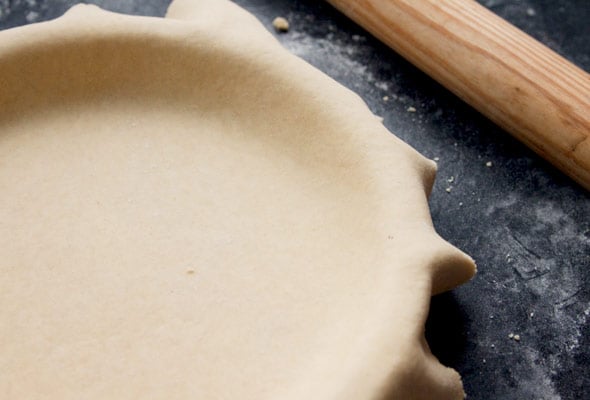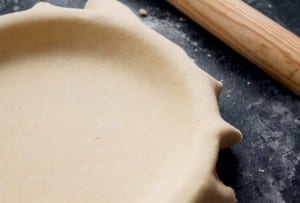
Jump To
My grandmother taught me how to make this basic pastry, called pâte brisée, when I was young. The one thing I learned simply by eating her endless variations on delicious tarts for dinner every night is that this dough can be used for just about anything—sweet or savory.–Jean-Georges Vongerichten
LC Grand-Mère Is Always Right Note
The moral of the above story from Jean-Georges? Grandma, er, Grand-mère is always right, perhaps most notably when it comes to making rich, buttery, flaky pastry.

Pâte Brisée
Ingredients
- 1 3/4 cups all-purpose flour, plus more for the work surface
- 1/2 teaspoon kosher salt
- 6 tablespoons (3/4 stick) unsalted butter, preferably cultured, cut into pieces and chilled
- 2 tablespoons plus 1 teaspoon vegetable shortening, chilled
- About 2 tablespoons cold water
- 1 large egg
Instructions
- Mix the flour, salt, butter, and shortening on low speed in a mixer fitted with the paddle attachment, until crumbly. With the machine running, add 2 tablespoons cold water and the egg. Beat just until the dough comes together in large clumps.
- Divide the dough in half and press each portion into a 1-inch-thick round disk. Wrap each portion tightly in plastic and refrigerate until firm, at least 1 hour. (You can refrigerate the tart dough for up to 3 days; let stand at room temperature for 15 minutes before rolling. Alternatively, the dough can be frozen for up to 1 month; thaw in the refrigerator overnight before rolling.)
- On a lightly floured surface with a lightly floured rolling pin, roll 1 piece of dough into a 10-inch round. Carefully transfer the dough to an 8-inch round fluted tart pan with a removable bottom, pressing the dough gently against the bottom and up the sides. Trim the edges against the side if necessary.
- Line the dough with foil, then fill with dried beans or pie weights. Freeze overnight or until very hard.
- To blind bake the tart shell, preheat the oven to 375°F (190°C).
- Bake the frozen crust until the edges are set, about 20 minutes. Remove the foil and beans. Poke holes evenly over the bottom of the crust with a fork, then return to the oven. Bake until the bottom is set and the crust is blonde, about 8 minutes. Let cool in the pan on a rack.

Nutrition
Nutrition information is automatically calculated, so should only be used as an approximation.










If you have a lot of pastry left over after making your tart and it has become dry just put it back in the food processor and blitz for a few seconds with a couple of drops of water and it’s good to go again.
Can’t wait to try your trick, Pensky. Thanks!
Can you make this dough well if you only have a hand mixer?
Jacki, yes, you absolutely can. It just will take a bit more care. Make sure to pay attention to what the dough is supposed to look like at every step. That will be the clue that you’re doing fine.
After screwing around with different recipes including handed down French mom’s recipes I find this to be reliably flaky, buttery, crispy–just perfect, even though I use white whole wheat which seems to be the killer for all other recipes.
So glad you like it, Silke! Thanks for letting us know.
I think it was too long a holiday——I blind baked the Pate Brisee yesterday and forgot to put the aluminum foil between the dough and the rice. Duh!!! But thanks to my lovely husband we managed to get all the rice back out with a spoon and saved it. I’ve only made a hundred quiches or so in my life, so I’m still quite the beginner. 🙂
Silke, I beg to differ. I don’t think it was too long a holiday, just perhaps more well-deserved relaxing than you’re accustomed? Either way, we’re chuckling with you, not at you. Many thanks for sharing, and give that lovely husband of yours an extra squeeze for us.